- remind me tomorrow
- remind me next week
- never remind me
The X Button
Still Fighting It
by Todd Ciolek,

I normally start these columns off by discussing a game I like, but this time I'm going to mention an entire series I don't care for: Virtua Fighter. This is particularly relevant now, since Sega just announced that Virtua Fighter 5 Final Showdown is coming to Xbox Live on June 5 and PlayStation Network on June 6.
It makes me wonder: why don't I care about Virtua Fighter? I have a weakness for fighting games in general, to the point where I'll dig up obscure and terrible ones. Virtua Fighter is one of the few that doesn't interest me. It could be the characters, as I've always found them to be the blandest bunch in the entire fighting genre (well, OK, Kensei: Sacred Fist is worse). It could be the focus on realism and techniques, which doesn't really satisfy someone who likes games to be outlandish whenever possible. It could be the Virtua Fighter anime series, which is actually enjoyable in its dubbed self-parody. It disappoints me that the actual games are so straight-faced.
However, I think it comes down to first impressions. I remember when the original Virtua Fighter arrived in arcades. It was the first 3-D fighter, and it looked like it. The characters were stiff mannequins, the gameplay was equally rigid, and I didn't enjoy it at all. I believe I preferred subsequent 3-D fighters just because they all looked a little looser than Virtua Fighter, and I was more forgiving to the early Tekkens and Toshindens.
That clings even today. When I see the new Virtua Fighter looking like this…
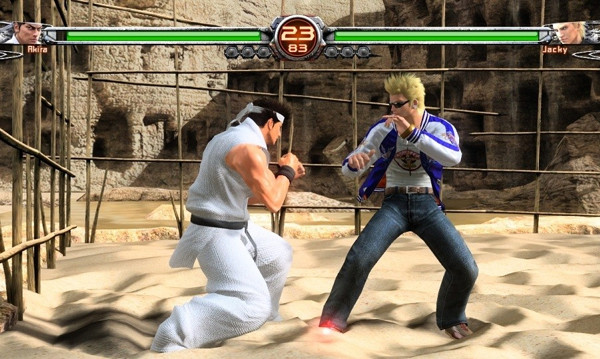
...I just see this…

So I should apologize to Virtua Fighter and its fans. This is probably no one's fault but my own.
NEWS
TOKITOWA'S HEROINE HAS IDENTITY DISORDER, STILL LOOKS LIKE A CARTOON
Imageepoch's upcoming PlayStation 3 RPG Toki to Towa, or Tokitowa, initially sold itself on looks: its backgrounds are technically 3-D, but the characters are 2-D creations designed to resemble an actual anime production as much as possible. Aside from that, the game appeared to tell a standard yarn about a princess named Toki, whose marriage ceremony is rudely interrupted by an invading army. Yet Imageepoch recently revealed a twist straight from Grandia II or Soul Hackers: Toki's hiding a second personality named Towa, and she violently emerges to confront the wedding crashers.
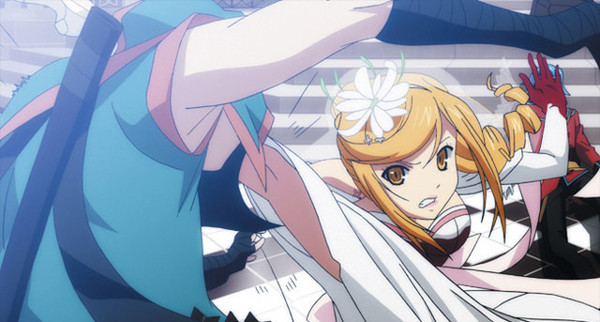
This idea isn't wasted on cutscenes, either. Toki usually attacks from a distance during battle, but she can change into Towa, who prefers up-close methods of combat. It also lends new meaning to the game's title, which now translates to both “Time and Eternity” and “Toki and Towa.” Imageepoch even went so far as to let Towa take over the game's Twitter feed for a while.
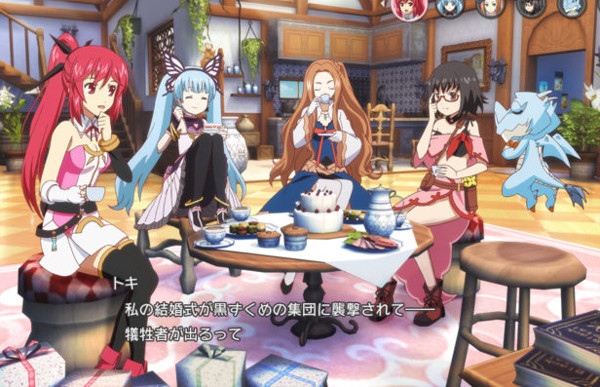
Imageepoch also introduced three additional characters: Wedi, Enda, and Reiko. All of them apparently join Toki/Towa and her blue-haired, player-named husband. He's noticeably absent in most of the game's new screenshots.
KINGDOM HEARS 3D GETS CLOSER TO ACTUAL KINGDOM HEARTS III
No, Kingdom Hearts 3D isn't a poorly disguised Kingdom Hearts III. It's another side-story, one that brings the series to the 3DS and twists its “3D” appellation to mean Dream Drop Distance. It follows Kingdom Hearts Re:coded in the franchise's grand pile-up of Square Enix properties and Disney characters, and it finds heroes Sora and Riku guarding various dimensions against long-term mad doctor Xehanort. Those dimensions include more Disney-licensed realms: Pinocchio, The Hunchback of Notre Dame, Tron: Legacy, Fantasia, and The Three Musketeers (the Mickey Mouse version, anyway). The Square half of the equation brings in characters from the DS action-RPG The World Ends With You. And they're grouchy as ever.

The “Drop” part of the title refers to the battle system, in which players control both Sora and Riku. Attack enemies, and you'll fill up a Drop Gauge. Let it run dry, and you'll automatically switch over to controlling the second hero. The “Dream” part derives from the Dream Eaters, sidekick creatures who provide Sora and Riku with special abilities that can be anything from freeze attacks to enemy-juggling combos. These Dream Eaters are earned in the game proper, but they're also available through AR cards, and Square Enix offers three cards to anyone who reserves the game in North America.
As for the “Distance” part of the title, it's apparently just a reference to the game's dimension-spanning quest. It could also denote the lengths to which Square Enix will go to avoid making Kingdom Hearts III just yet, but…eh, that doesn't quite work. Allegory or not, Kingdom Hearts 3D is out on July 31.
TALES OF TACTICS COMBINES RPG HEROES, SITS JUST OUT OF REACH
Tales fans are accustomed to disappointment. The franchise they favor is one of Japan's biggest RPG producers, but many promising Tales titles never came to North America. Now there's a new Tales offering, a crossover strategy game called Tales of the World: Tactics Union, and it's an Android smartphone title that'll likely never be translated for the West. Perhaps the two different types of disappointment will cancel each other out.
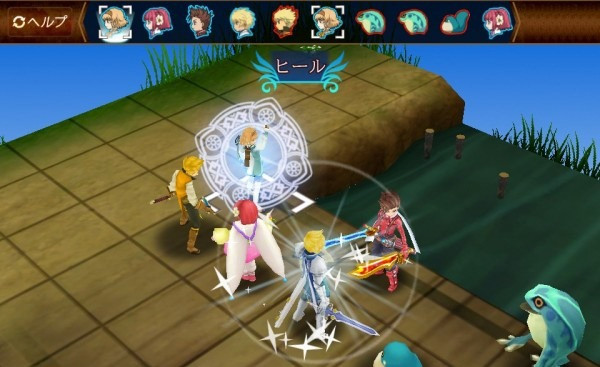
Tactics Union's battles draw in characters from through the series, and the roster thus far includes Lloyd from Tales of Symphonia, Guy and Natalia from Tales of the Abyss, Norma from Tales of Legendia, Rubia from Tales of the Tempest, Sophie and Asbel from Tales of Graces, and Flynn from Tales of Vesperia. While the game's made for the Android platform, it's distributed by KDDI, and it requires the company's Smartpass subscription to play. That, along with the demands of translating an RPG, will probably keep it exclusive to Japan. Perhaps it's no great loss compared to the other Tales titles that have stayed there.
FEATURE: THE FRINGE FIGHTERS
Any gaming fad has its side attractions, the flattering imitations and stuttering experiments that latch on and fall away like short-lived remoras. The fighting-game craze of the 1990s had plenty of those, and nearly all of its hangers-on are forgotten today. Titles like BloodStorm and Tattoo Assassins retain a certain infamy, but no one really sheds tears over Breakers Revenge. Few cherish Kaiser Knuckle's memory. Rarely is Ashura Buster lauded as a classic (though it almost is). And you'll seldom see Knuckle Heads, Angel Eyes, Superior Soldiers, Heaven's Gate, Blandia, or Deadly Moves mentioned when geeks discuss the fighter classics of their youth.
Fringe fighters are still with us today. As new Street Fighters and Mortal Kombats ride high, smaller companies create new fighters or repackage old ones. Recent years have already seen a swiftly dismissed Toshinden revival, the embarrassment of Twinkle Queen, and Windy X Windam, a DS attempt so awful it may have killed its developer. Yet we've also seen more accomplished offerings, from the surprisingly complex Arcana Heart 3 to the recent Skullgirls. And there's another round of potentially under-the-radar fighters ahead, and it's an open question as to where they'll land.
AQUAPAZZA
Several recent fighters have borrowed from visual novels: Golden Fantasia X is based on a chunk of the long-running When They Cry series, and Phantom Breaker (delayed in the U.S. yet again) took one character apiece from Steins;Gate and Chaos;Head. The arcade fighter Aquapazza, however, doesn't settle for just one anime or manga or visual novel. It's a giant gob of characters from various Aquaplus titles, some of which should be familiar to anime viewers on these shores. The main cast samples from Utawarerumono, Tears to Tiara, and To Heart 2, with several playable characters from each. The roster expands further into the Aquaplus and Leaf catalogs with a lineup of partner characters who leap out in the midst of battle.
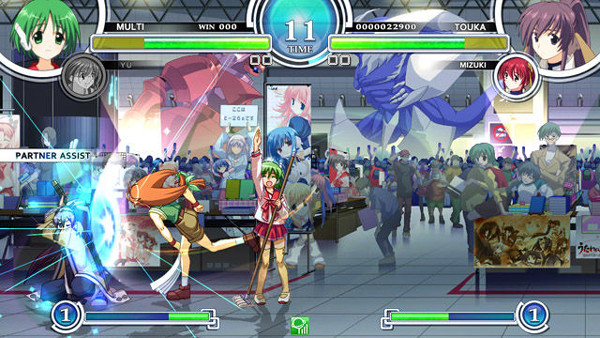
Aquapazza looks like a typical anime-derived fighter, but it's the work of developer Examu, whose Arcana Heart series hid some detailed play mechanics beneath a veneer of schoolgirls. Inspired by its dating-sim origins, Aquapazza uses an “Active Emotion System” in an attempt to stand apart from the typical 2-D fighting game. A character's mood swings from high to low depending on the player's chose style: an aggressive approach boosts your spirits and ups your attack power, while blocking too often brings you down and lowers your defense. This also ties into the varied selection of partners, who offer projectile attacks, hand-to-hand moves, or power-ups when they're called upon. Perhaps it'll scare off Western players with the overt anime collusion, but Aquapazza's already received a fair share of attention. And its PlayStation 3 version may get more notice yet when it arrives in Japan this July.
CHAOS CODE
Chaos Code is another fighter that may have something beyond a slick anime sheen. Sure, most of the characters fit into stereotypes and most of those stereotypes are variations on “scantily clad woman,” but there's an interesting lineup of options when it comes to gameplay. Upon choosing a character, players pick from several different special moves (as in Street Fighter) and either a running or dashing style of movement. In addition to the guard-breaks and cancels that most of today's fighters have, Chaos Code has “chaos shift” and “exceed chaos” maneuvers that allow for vicious combination attacks.

Though Sega's backing the game for its arcade release and an upcoming PlayStation 3 version, Chaos Code is the work of PK Digital, the Taiwanese outfit responsible for the 2004 doujin fighter Super Cosplay War Ultra. Symbolizing the increased overlap between underground developers and professional fighting games, Chaos Code looks nearly as impressive as an established studio's work. There's something about the backgrounds and animation that recalls the last crop of Neo Geo fighters, and that's not a terrible thing. And though we may note the largely generic cast of characters, there are a few standouts: Catherine, an apparent nod to PK Digital's cosplay history, changes outfits with nearly every attack, and a chef named Bravo Peperoncine hammers his opponents with food, kitchen implements, and his own waitstaff.
PERSONA 4: ARENA
Maybe Persona 4: Arena isn't really a fringe fighter, since it's based on a highly popular RPG. Atlus also has it fast-tracked for a domestic release on the Xbox 360 and PlayStation 3 shortly after it hits Japan this August. If Persona is new to the realm of fighters, developer Arc System Works certainly isn't. They're known for Guilty Gear and BlazBlue (and maybe Battle Fantasia), and Persona 4: Arena has the same hi-res artwork and unremittingly flashy effects. It plucks a dozen characters from the most recent Persona titles, including Akihiko, Aigis, and Mitsuru from Persona 3 and almost every major player from Persona 4—plus an original android warrior named Labrys. It sells itself to Persona fans with in-jokey features (some characters can wear glasses) and a story mode, though there's nothing so elaborate as the original games' social simulators.

Will Persona 4: Arena appeal to the fighting-game crowd? Impressions are limited to those who've found the Japanese arcade edition, but it looks nearly as robust as BlazBlue. Characters use their Persona sidekicks extensively in battle (this is where all of the JoJo's Bizarre Adventure fans cry rip-off), but these alter-egos can be knocked out of the game if they're damaged too much. Each character also has reversal moves that can stop a particular nasty combo, and losing 65 percent of a health bar puts a character in a powered-up “Awakened” state, giving them one more chance to turn the tide. Still, Persona 4: Arena has instant-kill attacks that can end a match any time, and many devoted fighter fans hated that sort of thing when it showed up in Guilty Gear.
AND THE REST
Among the other fighters slinking around the outskirts of the industry, the biggest mystery may be Shin Koihime Musou, a game based on semi-popular visual novel/anime franchise. Essentially Romance of the Three Kingdoms told via anime heroines, the fighting game fell out of the spotlight not long after it was announced in 2011. It popped up in Japanese arcades (and any Western ones that imported it), and it was even shown at the recent Amusement Expo in Vegas, complete with awkwardly translated flyers. No home version was announced, however, and few people seem to care.

The latest game from Atlus' Power Instinct series also wove through arcades without getting a home release. Gōketsuji Ichizoku Matsuri Senzo Kuyou (above), the fifth game in the largely comical franchise, arrived in Japan back in 2009, sporting five newly playable characters (mostly relatives of series regulars) designed by artist Range Murata. The reception apparently wasn't good enough to justify a home version, and Atlus didn't bother bringing it to the Xbox 360 or PlayStation 3. Still, it remains one of the weirder fights in recent memory; the soundtrack and backgrounds are bizarrely humorous, and the cast now features at least four shape-shifting elderly women.
Vanguard Princess got noticed back in 2009 for two reasons: its animation was exceptionally sharp for an indie fighter, and its characters were shamelessly, aggressively immersed in “moe”-brand anime girl designs. Some devoted competitors were also drawn to its combo systems and the techniques of its helper characters, and in 2011 a rumor arose that the game would show up on Xbox Live in the next year. Well, it's next year, and there's no further sign of any home version for Vanguard Princess. Still, a rumored release is better than the new Power Instinct got.
NEXT WEEK'S RELEASES
DRAGON'S DOGMA  Developer: Capcom
Developer: Capcom Publisher: Capcom Platform: Xbox 360/PlayStation 3 Players: 1 MSRP: $59.99 Dragon's Dogma is yet another Japanese take on a Western genre, but this one's not swiping from Gears of War. It's actually feeding off the broader canon of Western fantasy fiction, including both old-school Dungeons and Dragons stylings and even older Lord of the Rings elements. It's set in a fairly down-to-earth realm of grubby villages, medieval power structures, and fearsomely powerful dragons. One such specimen descends on a village one day and rips the heart from a brave but doomed human—and that's the player's customized character. Curiously alive and inextricably linked to the dragon, the hero or heroine takes the title of Arisen and tries to hunt down the beast. Yes, it's a bit like Dragonheart, but Dragon's Dogma is less about plot and more about the immense world that stands between player and dragon. And it holds all of sorts of quests, conveyed in speech reportedly inspired by fantasy author George R.R. Martin. You can tell because everyone says “Ser” instead of “Sir.” Even though it's a single-player experience, Dragon's Dogma rarely leaves the protagonist alone. Three “pawn” characters can join the Arisen in battle, and they're hardly faceless assistants. Almost as customized as the main character, pawns chatter away and wield a variety of combat techniques. When it comes to character classes, players have at least nine. Archer and warrior types are standard issue, but there's also a market for quick Strider and Ranger party members. These classes come in particularly handy in the game's monster-grabbing encounters. Just about every creature can be seized for some purpose: goblins can be chucked around, and players can scale chimeras, griffons, and other large beasts like the bosses in Shadow of the Colossus. And while some will surely complain about the lack of a multiplayer mode, the game allows players to share their customized pawns and cooperate in attacking monsters indirectly.
|
MARIO TENNIS OPEN Developer: Camelot
Developer: Camelot Publisher: Nintendo Platform: Nintendo 3DS Players: 1-4 MSRP: $39.99 Every Mario Tennis game is another excuse for a dedicated few to talk about how the original Mario's Tennis appeared on the Virtual Boy, and how Nintendo cruelly murdered the Virtual Boy after barely giving it eight months on the market. But pieces of it survived. We don't have Vertical Force or Jack Bros. on the 3DS virtual console yet, but we do have a line of tennis-based Mario games on more successful Nintendo systems. In truth, the whole franchise was born with the unpossessive Mario Tennis for the Nintendo 64, but we must humor the Virtual Boy crowd. They have it rough. Mario Tennis Open has the same cartoonish vision of the sport as its predecessors, populating its court with various Nintendo characters who serve, lob, and backhand tennis balls with the exuberance they'd normally show in the latest Mario Party or Mario Kart. The character roster features Mario (of course), Luigi (of course), Peach (of course), Daisy, Wario, Waluigi, Donkey Kong, Yoshi, Diddy Kong, Boo, Bowser, Bowser Jr., and four other characters (I hope for Samus Aran and Kid Icarus). There's one more character in the player's Mii, who can be imported into Tennis matches. The system's StreetPass even allows Mii matches between people who walk around with their 3DSes running. Though it lacks the RPG-like character building of previous portable Mario Tennis titles, Open compensates with a good four-player mode that works in local and online options, plus a court selection that includea a lava-bordered cage at Bowser's palace and an icy penguin zone. There's no underwater court that extends forever in all directions, but you can't expect the game to reference every piece of Mario's legacy.
|
NOT Available Next Week:
Atelier Meruru, the final game in the Atelier franchise's Arland sub-trilogy, was delayed to the week of May 29.
discuss this in the forum (45 posts) |
this article has been modified since it was originally posted; see change history